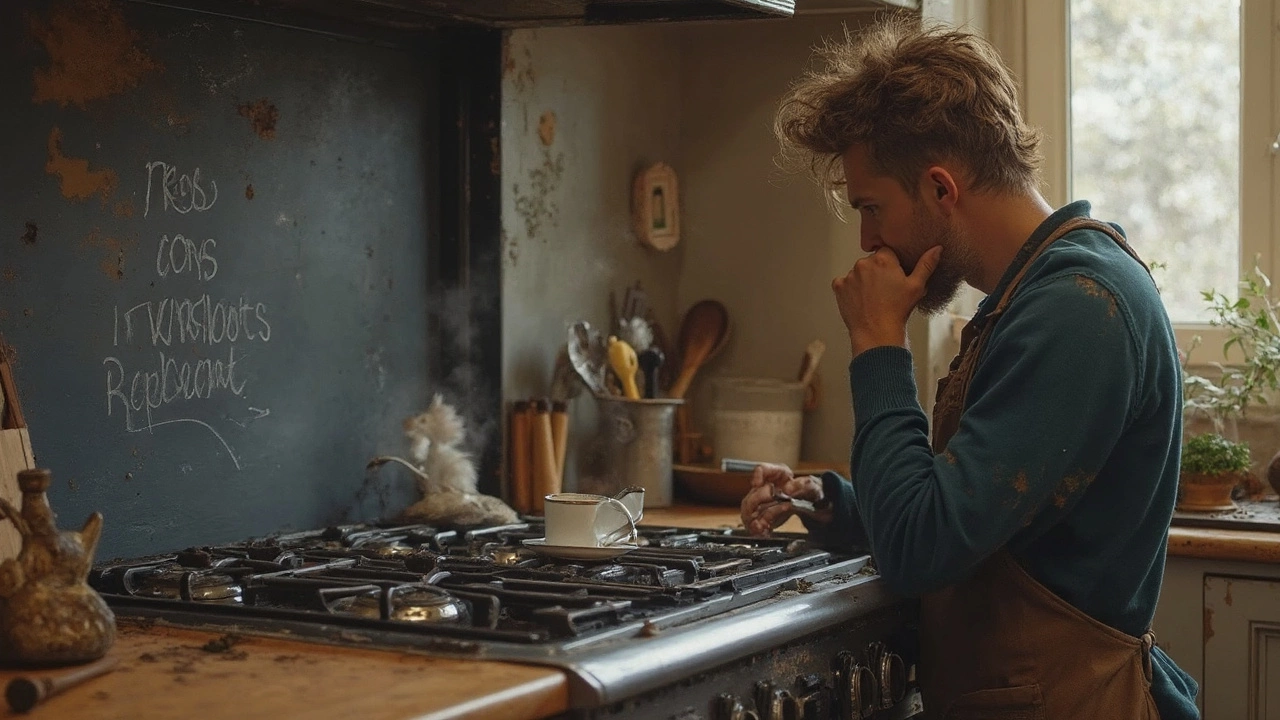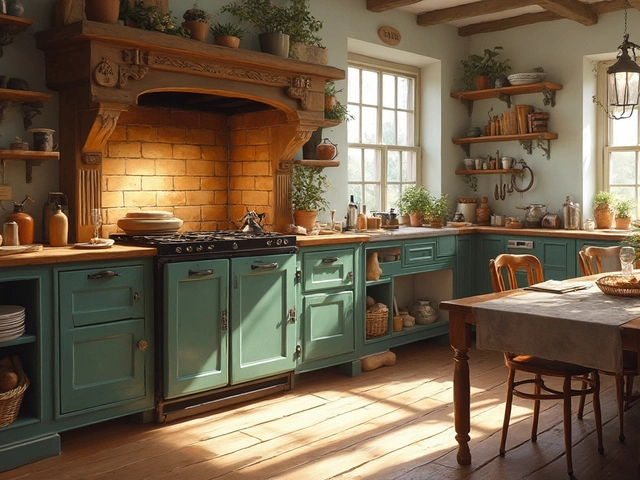So, you've been cooking up a storm over a decade on your trusty range. But lately, things aren't heating up like they used to. Is it time to fix it or just pick a shiny new one? First off, let's get into some key things to weigh when deciding on this kitchen conundrum.
Think about the cost versus the age of your range. Typically, experts say that if repair costs are over half the price of a new one, you might want to consider retiring it. However, if it's something minor like a faulty knob or a burner that's just being fussy, a quick fix could be super cost-effective.
Plus, some parts of your range might be covered under the manufacturer's warranty even after several years, which is a cool surprise. And, let’s be honest, knowing if your repair expenses will start piling up can steer your decision-making boat in the right direction.
- Deciding Factors for Repair
- Common Problems with Old Ranges
- Cost-Benefit Analysis: Repair vs. Replace
- DIY Fixes and Maintenance Tips
- When It's Time for a New Range
Deciding Factors for Repair
When your 10-year-old electric oven starts acting up, knowing whether to repair it is crucial. Let’s dig into what really matters in making this decision. First, get a sense of your range’s history. Is this the first time it's given you trouble, or has it been a repeat offender? Understanding the pattern of issues can highlight whether it's worth fixing or just ditching it.
Also, hit the pause button and think about the warranty. Many people don't realize that manufacturers offer extended warranties on parts that can still be in play even after a decade. If, for instance, you’re part of the lucky club whose warranty covers the repair, that’s a no-brainer win.
And let's not forget the cost-to-repair versus replacement-price metric. A practical rule is if repair expenses are creeping above half of what a new range would cost, consider swapping old for new. Throw in the potential energy savings from a new, more efficient model, and it might just pay for itself through lower electric bills over time.
A good way to get a grip on costs is to call in a technician for a diagnosis. They usually have a wealth of experience and can tell you if your specific model is known for certain failures or parts that are expensive to replace.
Then there’s personal attachment and preference—if your range perfectly matches your kitchen setup or culinary style, repairing might be the better bet even if it costs a bit more.
- Warranty Check: See if you’re covered.
- Repair Costs: Compare with new range prices.
- Energy Efficiency: Newer models might save electricity.
- Professional Advice: Get a tech's diagnosis.
- Aesthetic & Functional Fit: How much you love your current setup.
These factors don’t just stay on paper—they impact your daily cooking convenience and energy bills. So weighing these components thoughtfully can lead you to a smart, money-saving choice.
Common Problems with Old Ranges
When your 10-year-old electric oven starts acting up, it's not always a mystery. Some issues pop up more often than others, and knowing them can make a world of difference.
A big thing that goes awry is the heating element. You might notice that the oven's taking longer to cook your lasagna, or it's coming out unevenly browned. This usually means the element isn’t heating evenly or is burnt out.
Then there's the thermostat. If your cookies are turning into charcoal or your roast is endlessly raw, the thermostat might be at fault. This part's like the brain behind your oven's temperature control, and when it's off, your cooking can become a guessing game.
Another common gremlin is a faulty ignition switch in gas ranges. If you're hearing clicking sounds but don't see flames, the igniter might not be sparking. This could need replacing, especially if you’re still using the original one.
Control panel issues can also bug you. If buttons aren't responding or the display is flickering, you might be dealing with a worn-out control board, usual wear and tear over a decade of use.
- Heating Element Problems: Slow or uneven cooking.
- Thermostat Issues: Inaccurate temperature control.
- Ignition Switch Failures: No ignition in gas ranges.
- Control Panel Glitches: Unresponsive or flickering display.
One more heads-up: odd odors or smoke can mean lurking gremlins, like faulty wire insulation or even an overheating oven. Don't ignore these signs and get them checked by a pro if they won't go away.
Got some handy skills? You might even tackle some of these problems yourself, but knowing your limits is key. It's always better to avoid more damage than to save on a professional fix.

Cost-Benefit Analysis: Repair vs. Replace
Alright, let's tackle the big question: Should you repair your dinged-up stove or toss it for a new one? It's like deciding whether to patch an old relationship or move on. Here's how you break it down.
Start with the obvious: Cost. Take a look at your oven's issues. Did the heating element bail on you, or is it a motherboard meltdown? Simple repairs, like replacing a heating coil, might set you back just around 50 bucks plus labor. But a motherboard? Now we're talking a few hundred. If repair costs start climbing over 50% of a newer model price, think about replacing. Yeah, brands and features can make prices vary, but that rule of thumb keeps you clear-headed.
Also, consider efficiency. Newer models are super energy-savvy. If your old pal is guzzling energy, those monthly bills might cut deeper than a one-time fix. A new electric oven might have an upfront cost, but imagine saving on those bills long-term. It ain't just about the dough today; it's about the money you can save over months and years.
But hey, don't rush to the store just yet. Look at your range's track record. Has it been a money-pit lately? Frequent breakdowns probably mean more headaches on the horizon. But if it's just one hiccup after a pretty chill decade, a range repair might buy you a few more years of service.
Let’s round this out with a quick glance at some typical costs:
| Issue | Average Repair Cost | Average Replacement Cost |
|---|---|---|
| Heating Coil | $50 - $100 | $500 - $2,000 (new range) |
| Temperature Sensor | $90 - $200 | Included in new range cost |
| Motherboard | $200 - $400 | Included in new range cost |
Bottom line? Weigh those costs, consider future maintenance, and think about the energy efficiency of newer models. Go with what's going to keep the kitchen vibes alive and your wallet happy.
DIY Fixes and Maintenance Tips
If your range repair checklist is getting longer, fear not! Tackling some simple fixes yourself can save a heap of cash. For starters, a common problem is that the burners don't heat evenly. Usually, this just means a quick cleaning session. Food and grime can build up, messing with the connections. A soft brush or a bit of vinegar should do the trick.
Next, if a range burner isn't sparking, check the ignition switch. This involves unplugging the range, removing the burner grate, and accessing the ignition switch beneath. Sometimes just reseating everything snugly solves the problem.
For an oven that's not heating well, the culprit might be a faulty bake element. You can check this by switching off the power, and visually inspecting the element for breaks or blisters. If needed, replacing it is pretty straightforward and can be done with some basic tools.
Regular maintenance helps keep your range running smoothly, too. Aim to clean the oven regularly with a mixture of baking soda and vinegar. This natural cleaner is effective and safe. Also, make it a habit to check seals and gaskets to ensure that heat isn't escaping, which can skew cooking times and waste energy.
Here's a handy list of maintenance tasks to ensure your range stays in top shape:
- Yearly Checks: Inspect and replace the oven's light bulb and check the control panel for signs of wear.
- Monthly Maintenance: Clean the drip pans, burner reflectors, and control knobs.
- Weekly Routine: Wipe down the cooktop and clean any spills to prevent them from hardening.
A little effort goes a long way in avoiding more significant problems down the line. Plus, these maintenance tips ensure your 10-year-old electric oven lives its best life for years to come!

When It's Time for a New Range
Alright, so you're thinking maybe it's time to part ways with your 10-year-old range. That's a decade of trusty service, but there are a few signs you can't ignore. Let's break down when hanging onto an older appliance just doesn't make sense.
First, consider the cost of constant repairs. If you find yourself calling the repair guy more often than tuning into your favorite TV show, that's a big red flag. Older models might start showing age through frequent burner and oven issues, which even the most seasoned DIY-fixer can't always handle.
Look into energy efficiency too. New ranges have come a long way in terms of using less power, saving you some dough on your energy bills. It's a smart move if your current range is guzzling power like there's no tomorrow.
On top of that, when spare parts become harder to find and more expensive, that's your cue. Manufacturers often phase out parts for older models, meaning a simple fix can require a lot more effort and cash than it used to.
Finally, consider safety. If there's a persistent gas smell or electrical faults, it's not worth the gamble. Newer models meet more stringent safety regulations, offering peace of mind while you whip up culinary masterpieces.
- Unreasonable repair costs and frequency
- High energy consumption
- Lack of availability and high price of spare parts
- Safety concerns and code compliance
Recognizing these issues, it might be best to streamline your decision towards replacing that old range. You’ll not only enjoy the benefits of new tech and better efficiency, but also keep your kitchen a safe and pleasant place to cook.




